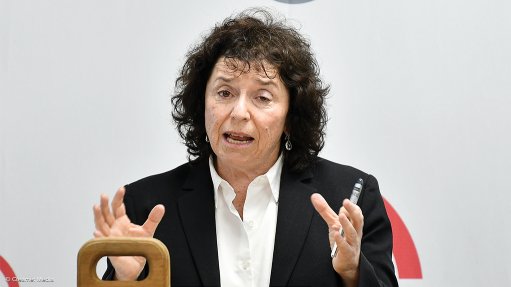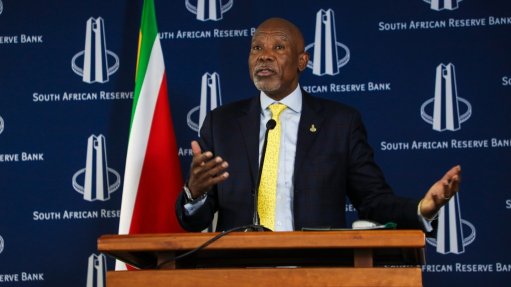Mavuso says third Budget’s expenditure reviews, grant reform bodes well
While it did take three months and three revisions for South Africa’s national Budget to be passed, Business Leadership South Africa CEO Busi Mavuso deems it positive that this budget has the political support to pass all the Parliamentary processes ahead of it and instil investor confidence.
She explains in her latest weekly newsletter that although three budgets in a year is unprecedented, the political mechanisms have brought South Africa to “a positive place”.
Importantly, the amount of infrastructure investment of R1-trillion over the next three years will help get economic growth going and create meaningful jobs, but local government infrastructure spending is an area of concern for Mavuso.
She hopes to see more infrastructure investment in the local government sphere by crowding in private-sector spending through public-private partnerships (PPPs).
The finalisation of revisions to PPP regulations last year should enable that, but a concerted effort and political will by municipalities should be encouraged, she says.
To this end, the Operation Vulindlela 2.0 process will include a special effort to boost municipal performance and PPPs should be a central mechanism to realise more sustainable and cost-effective infrastructure spending.
Mavuso explains that the R1-trillion infrastructure investment figure was made despite National Treasury having to cut some expenditure lines to accommodate lower growth and constrained tax revenue.
Positively, the Budget includes spending on electricity, rail, water and other transport infrastructure, the latter of which has been an albatross around the neck for South Africa’s economic performance and global competitiveness.
Mavuso cites estimates that Transnet’s inefficiencies, particularly at ports, costs the country R1-billion a day in economic activity.
“Our mines and factories cannot get their output efficiently to ports and from there to markets in the rest of the world. Although there have been improvements recently, South Africa still has among the most expensive ports in the world,” she states.
Further, she notes that President Cyril Ramaphosa’s State visit to the US last week highlighted the need for dependable and stable trading relationships with major world markets. Through its tariff moves, the US administration has severely disrupted a global trading system based on equal treatment and rules of conduct.
“South Africa has to deal with this reality. I hope our negotiators can make headway in forming agreements with the US, but, like the rest of the world, we must be prepared for a future that sees significantly reduced trade with America.”
Many commentators are arguing that trade will swing from West to East because of US isolationism, which means increased trade with China, India and other emerging markets, including across Africa, though Europe will remain a critical market for South Africa’s output too.
In that scenario, Mavuso explains, the global trading system is going to be more competitive, with a smaller market available for South Africa’s outputs. It will therefore be more important than ever for the country to operate efficiently.
POSITIVE POINTS
Mavuso says the third and final Budget has several plans to rein in expenditure that is not productive. With tax options being limited, government has had to find ways to contain expenditure.
Treasury’s spending reviews have already identified tens of billions of rands in potential savings from poorly performing or inefficient programmes. If government acts on these reviews, it may well mitigate the need for additional taxes in the 2026 Budget, Mavuso points out.
She says that for too long government has allowed spending to grow without evaluating whether that spending is delivering value to people. “The Budget process in future must look at underperforming government programmes and shut them down.”
Mavuso highlights another area of progress as Treasury mulling the replacement of the social distress grant that was established during Covid-19. This was never meant to be a permanent welfare support and has since become a large spending item in the Budget, costing most than R35-billion a year.
Should Treasury replace this grant with a job seekers’ allowance, it will make more sense to support people to access the job market. Mavuso says a carefully designed support programme that enables young people to access potential jobs is far more sustainable than a social distress grant.
Comments
Press Office
Announcements
What's On
Subscribe to improve your user experience...
Option 1 (equivalent of R125 a month):
Receive a weekly copy of Creamer Media's Engineering News & Mining Weekly magazine
(print copy for those in South Africa and e-magazine for those outside of South Africa)
Receive daily email newsletters
Access to full search results
Access archive of magazine back copies
Access to Projects in Progress
Access to ONE Research Report of your choice in PDF format
Option 2 (equivalent of R375 a month):
All benefits from Option 1
PLUS
Access to Creamer Media's Research Channel Africa for ALL Research Reports, in PDF format, on various industrial and mining sectors
including Electricity; Water; Energy Transition; Hydrogen; Roads, Rail and Ports; Coal; Gold; Platinum; Battery Metals; etc.
Already a subscriber?
Forgotten your password?
Receive weekly copy of Creamer Media's Engineering News & Mining Weekly magazine (print copy for those in South Africa and e-magazine for those outside of South Africa)
➕
Recieve daily email newsletters
➕
Access to full search results
➕
Access archive of magazine back copies
➕
Access to Projects in Progress
➕
Access to ONE Research Report of your choice in PDF format
RESEARCH CHANNEL AFRICA
R4500 (equivalent of R375 a month)
SUBSCRIBEAll benefits from Option 1
➕
Access to Creamer Media's Research Channel Africa for ALL Research Reports on various industrial and mining sectors, in PDF format, including on:
Electricity
➕
Water
➕
Energy Transition
➕
Hydrogen
➕
Roads, Rail and Ports
➕
Coal
➕
Gold
➕
Platinum
➕
Battery Metals
➕
etc.
Receive all benefits from Option 1 or Option 2 delivered to numerous people at your company
➕
Multiple User names and Passwords for simultaneous log-ins
➕
Intranet integration access to all in your organisation




















